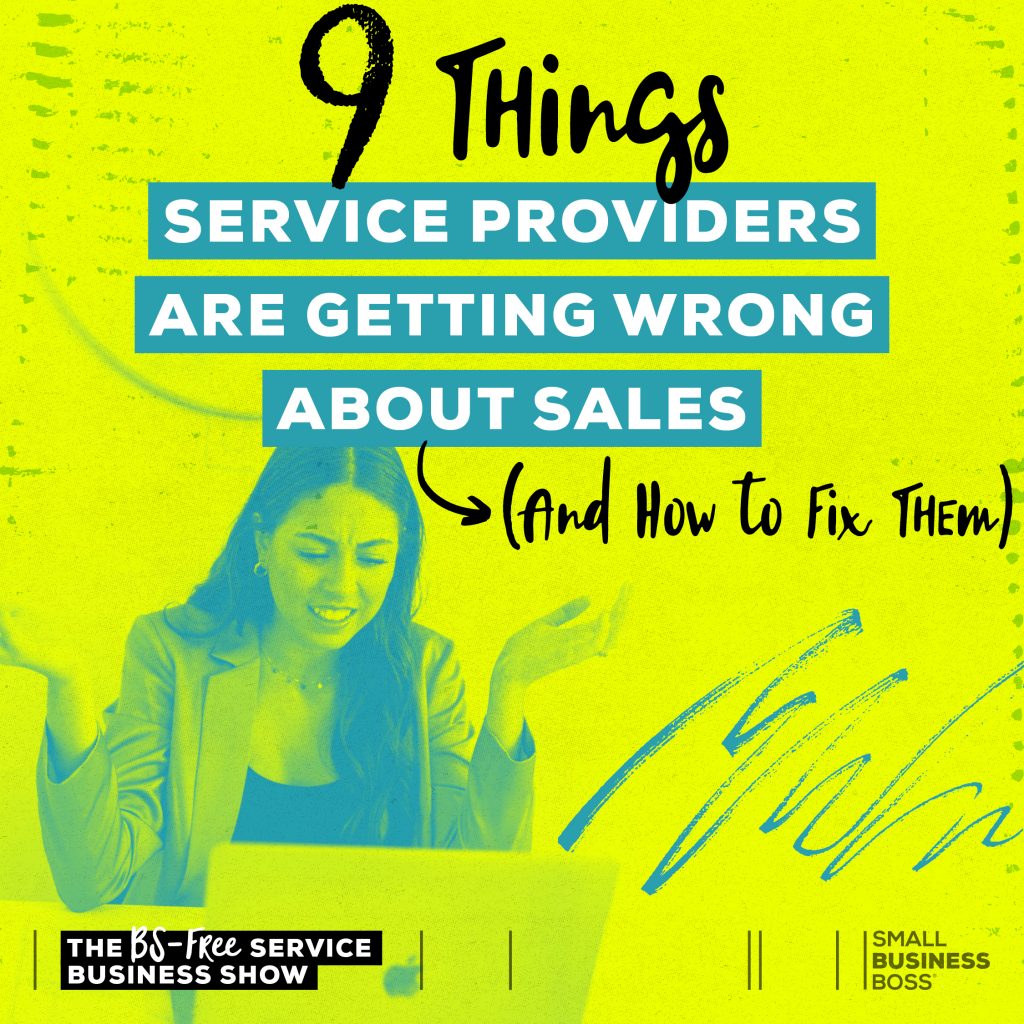
Nine Things Service Providers are Getting Wrong About Sales (And How to Fix Them)
When it comes to selling your services, it can be challenging to know if you’re getting it right, or if you’re inadvertently sabotaging yourself somehow. In this episode, I’m unpacking nine things I see service providers getting wrong, and we’re going to talk about how to fix them.
Today we’re kicking off a new series on sales and money here on the podcast, and we’re getting it underway with a look at nine specific things I see service providers getting wrong about sales.
Some of these we’ve talked about in past episodes, and others are ones I see emerging on a larger scale in an ever-shifting online business landscape. When it comes to sales strategies and tactics, there are a lot of manipulative practices that I see in action everyday.
The good news? The worst of them aren’t ones that are typically used by service providers, but there’s always potential for them to cross over, especially for those of us that run businesses that target entrepreneurs.
Which brings me to our nine things. So let’s dive in.
Table of Contents
#1. Confusing B2B and B2E Tactics
I’ve talked about this at length in the past, and I’m not ever going to stop as long as there are people out there that don’t make this distinction. The reality is that B2B is used as shorthand for ALL businesses, when there’s a huge gulf between selling to an actual B2B corporation, and targeting online-based entrepreneurs.
That’s exactly why we need to create a category called B2E, or business-to-entrepreneur, and understand how many times those tactics aren’t at all the same. Too many times, service providers take a tactic that’s common in the online business world, and think it should directly translate.
Spoiler alert: It doesn’t. From building a personality-based brand to email funnels, these typically aren’t going to work for corporate clients. Yes, there will always be exceptions, but they’re extremely rare.
By getting clear on who your exact target client is, and understanding the best way to sell to them, you’re going to stop wasting time doing things that don’t make an impact. For example, if you’re selling B2E, a tactic like cold outreach is less likely to work, while for B2B, it’s a much better fit.
Think critically about each sales tactic as it applies to your potential client. Skip the one-size-fit-all advice from online coaches who’ve never sold anything to a corporate client in their life.
#2. Poor Lead Qualification
One of the biggest reasons that people start their own business is so they can have more freedom in their schedule. So, when you’re stuck on an endless string of consult calls that go nowhere, it’s understandable that you’d get frustrated.
If you’re selling a service as a consultant, creative or agency owner, you need to be particular about who you get on a call with. You need to pre-qualify people before you have a conversation and ensure that you’re getting on a call as a way to discuss working together.
Fact is, you shouldn’t ever be giving away strategy on one of these calls. Strategy should be the first step in working together on a paid basis.
Now, you may be wondering, “Maggie, what about the free consult call?”
If you’re running a business where you deliver strategy or an end product like copy, design, project plans or anything of that nature you should NOT be doing a free consultation.
A free consult is a tactic used by coaches to give people a “taste” of what it’s like to work with them. This makes sense as coaching is hard to communicate the outcome of. Unfortunately, this has crossed over into other service-based professionals, and it’s doing you a disservice to provide this type of support or counsel for free.
The key is that you have a clear process for determining when and if a call should be booked. In my case, I have a series of questions I ask potential clients before they book a consultation, which includes their timeline and budget.
If you’re a coach, the free consult strategy should still be done with some screening in place to ensure a strong mutual fit, and with transparency that at the end you will discuss how you could potentially work together.
#3. Playing Games with Boundaries
A big part of managing your lead qualification comes down to creating boundaries about who you do and don’t get on a call with. But there’s a flip side to this we need to discuss. Yes, we need to qualify people, but it also doesn’t mean we need to play games in the sales process. One of my biggest pet peeves are the boundaries that many online entrepreneurs talk about putting up, as they’re designed to make us look important. However, that can easily backfire, as in our bid to look like we’re big time, we signal to our potential clients we’re too busy to engage with them.
A common way this shows up is that it takes too long to get on a call with a potential client. You absolutely need to protect your time, but are you really so overscheduled that you can’t take a call with a prospect for three or four weeks? My policy is to always have time available within a week unless I’m out of office.
Think about it from the perspective of your potential client. If they’ve reached out to three different potential service providers, and when two of them can speak to them within the week, and there’s one that can’t for weeks, what message does that send? It’s telling them from the jump that you’re too busy. And from a potential client’s perspective that’s not a great first impression to send. Plus, during that lag time the initial excitement is wearing off.
Even if you’re booked out and someone would need to book out months from now, if they’re a potential good fit, speak to them now. All this takes is having a one hour time slot on the calendar you keep free every week for new business calls. That’s it.
There are many other ways this shows up, but if you’re offering services, you need to be of service. You need to be willing to actually be responsive and helpful to potential clients. You don’t need to be immediately available, but you shouldn’t play games designed to make you look like a big shot either.
#4. Lack of Specificity
If there’s anything I’m obsessed with in business, it’s specificity. Many service providers get lost in the sea of sameness as a result of their lack of specificity, and in the sales process it’s a major faux pas.
Why? Because if you can’t communicate what you do, who you do it for and what specific results you deliver, it’s going to be hard to sell anything. Yes, this is basic sales and marketing 101, but it’s much harder than it sounds.
I know over the years I’ve definitely struggled with it as I wanted to help everyone or do all the things. I’ve learned that my business results are directly tied to my willingness to be ultra specific about what I do. Case in point: my agency. The more we’ve niched down by industry and with our services, the easier the sales process has been. There’s zero ambiguity about what we do, and how we do it, which makes getting to a yes so much simpler.
Watch for the kitchen sink approach to services. This is where you do everything, for everyone. You’re a copywriter/strategist/designer who works with coaches, course creators and wellness professionals. It’s hard to stand out when you’re all the things.
#5. Not Taking Ownership of Results
Listen, as service providers we do magical things for our clients. But we often fail to take ownership of the results we help to create, and we rely on fluffy claims about what we can do.
You know what sells? Results? And it’s not always about something you can quantify like time or money, but the results you create matter.
You need to be able to demonstrate that you make an impact by using customer stories, testimonials and case studies in the sales process. This can be done on a sales page, in a proposal or even just as an example when you’re talking to someone about working together.
What I’m not condoning here is you overpromising what you can do by using results that are not typical as proof. Instead, use stories that show what you can do without setting unrealistic expectations.
#6. Using a Cookie Cutter Proposal
If you send proposals to your clients, you need to stop using a cookie cutter proposal. I review a lot of proposals (for clients and when hiring contractors) and I can see a prefab, zero effort proposal a mile away. And if I can, your potential clients can too.
Stop looking at your proposal as a pain in the ass and start looking at it as the tool you need to make the sale. Because trust me, your proposal can be the make or break moment. Even if you’re not amazing on a sales call, you can still win that client with the right proposal.
Up your proposal game by taking time to revamp your existing template. Make it easy to customize it for each client and demonstrate that you put some effort by personalizing it. Then, go the extra mile to make it look good.
For bonus points: Spend some time ensuring the proposal process is streamlined and seamless. A clunky proposal process doesn’t do a lot to create confidence how things will be should you potentially work together.
And for the extra bonus round. I’ve said it before and I’ll say it again. I don’t care if you have packages, but not everything you do should be sold from a page on your website, even if you work with B2E clients. The more expensive what you’re offering is, the more you need a custom proposal.
#7. Not Sharing the Price
Later in this series we’re going to talk about pricing, but a common deal breaker, especially if you work in the B2E market is not sharing your price.
Prices shouldn’t ever be a surprise, yet there’s an increased trend towards people hiding or gating their pricing as a way to “convince” people in the sales process that it’s a worthy investment.
Boss, unless you’re really freaking great at sales, or you’re ready to use some icky tactics, this is a downright terrible strategy. Because pricing objections, they’re real objections no matter what that big name celebrity entrepreneur wants you to think.
People know what their budget is, and it’s not your job to try to strong arm them into the sale. It’s not a great place to start a potential client relationship as it’s eroding trust in the very spot you should be building it.
If your work is custom, use a starting price as a way to communicate the potential financial investment.
Finally, whatever you do, don’t make your potential clients jump through hoops by sitting through a webinar, filling out a massive application or something else simply to get pricing. While that’s commonplace for many courses or programs, it’s not providing a high-touch experience as a potential service provider.
#8. Not Following Up
I could write a book called “all the stories I told myself while waiting for potential clients to say yes,” as there are literally hundreds of reasons I make up in my head as I wait for a response. The majority of which are about how they don’t want to work with us, the pricing or some other fanciful story I’m concocting in my rich inner world.
I’m sure so many of you are right with me when it comes to the internal chatter you have going on once you talk to a potential client and/or send the proposal.
This is exactly why you need to have a rock solid, no objections follow-up process in place. Having a system (including dates and canned emails) you can send to follow-up takes some of the fear out of the process.
Because if there’s one way to lose a potential client, it’s by not following up. Not following up says you don’t care and you don’t want their business, even if the opposite is true.
Case in point, a couple weeks ago I sent the sign up link for a consulting session, and I was wondering why the person hadn’t followed through to the book the session. I made up a story in my head about how she decided it was too expensive and now it was going to be weird. Upon realizing I needed to follow up, I realized I’d sent everything to the wrong email and we ended up getting it all sorted out.
#9. Failing to Understand the Client Journey
Finally, when it comes to your sales process, we often don’t understand our customer’s journey with us. We’re so keen that we want them to decide right away, when many times they need much more time than that.
If you’re not sure what your typical client’s path is to working with you, from the point they discover you to the point they actually say yes, to engaging with you, this is worth taking some time to understand. Once you understand this, you’ll be better equipped to manage your potential clients through the sales process, as you’ll have a handle on their stops along the way.
For example, with our agency clients, I’ve learned that once we send a proposal the decision making process may take anywhere from a week up to a month. That’s been helpful for planning the steps and cadence of how/when I follow-up.
For those same clients, I’ve learned that we’re typically a just-in-time answer to a problem they’re having, so our speed from the first point of contact to when we have a consult call matters. In fact, I’ve lost more than one opportunity this year as we were simply not fast enough, which has made me reassess the process for booking consult calls.
On the flip side, with Small Business Boss, it’s not uncommon for people to listen to this podcast and want to work with me for months, or even years before it happens. The time from discovery to actually working together is extremely long, meaning I need to continuously build trust along the way. And because trust is a core focus, at the point someone decides the time is right, their decision to say yes happens quickly.
The insight into the client journey in two very different scenarios shapes the sales process, as well as all the inputs that go into that process. I’m willing to bet that for your own client journey, you can glean some insights to help you better support potential clients every step of the way.
Making the Most of Your Sales Opportunities
In this episode, we’ve covered a lot of ways you can strengthen your sales process. Many of these require small tweaks, so think about where you may need to spend a little time fine tuning your approach. Remember, as always, avoid the urge to try to tackle all of these at once. Aim for slow and steady improvement over time.
Next week, we’ll be talking about how to take a new approach to sales on online business. I’ll be unraveling some of the “business as usual” practices we see in action and talking about them in the context of how we as service providers can sell in a way that our potential clients can trust.


